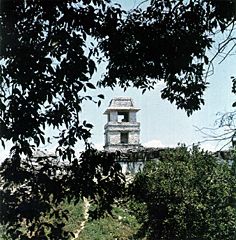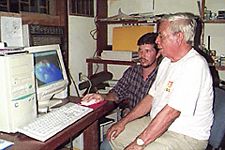| home | First Round Table: Preface |

|
The Primera Mesa Redonda de Palenque was a working conference which took place at Palenque, Chiapas, Mexico. The suggestion that a "round table" on Palenque be held came about one evening in August 1973 when Gillett Griffin, David Joralemon, Linda Schele, my husband Bob, and I were sitting on the porch of our Palenque home and working headquarters, Na Kan-Balam. We felt that, if a few people could get together who were particularly interested in the art of Palenque, it would be a great thing.
Enthusiasm grew by leaps and bounds. When we returned home to California, the telephone started ringing, all of those interested wanting to have the first Mesa Redonda immediately. December 14-22 was settled upon as being the time most convenient for those wishing to attend. Plans got underway, with the result that 14 universities from the United States, Mexico, and Canada were represented. Unfortunately, many from Mexico were not able to attend because of previous plans which could not be changed on such short notice. At first it was thought that the meeting should be open only to those participating in the conference. However, it became evident that many persons from Palenque were very interested and wanted to find out all they could from visiting scholars who were also interested in Palenque. Consequently, not only were planned meetings held daily from 9 a.m. until 12:30, and again from 8 until 10 p.m., but they were also held daily from 5 p.m. until 6 p.m. for all persons in the village who were interested. The Palenque guides attended all of the meetings. After the first day, the regular meetings were also open to everyone, as we found that the interest was so great that students were coming from a number of universities in Mexico, including the University of Mexico, the Universities at Villa Hermosa, Campeche, Merida, and Tuxtla, and the University of the Americas. The average attendance at the 5 to 6 o'clock meeting was around 50 persons, and the day that Dr. Emanuel Velasco Saurez, Governor of Chiapas, attended, there were 104 persons. Most of the meetings were held in the new open-air champa of Sr. Moises Morales while others were held at Na Kan-Balam. Two projectors were available for those using slides. Brief papers were given, followed by much discussion. Afternoons were spent at the site. Because we have received so many requests for immediate publication of the papers of the Mesa Redonda, it was decided to publish the material now. It was though best to retain the style of each individual author, although we know there are inconsistencies in style and terminology used. ... At the last session of the Primera Mesa Redonda, it was suggested by Moises Morales that the rulers of Palenque be given Chol Maya rather than English or Spanish names, as Chol is the language that the ancient people would have spoken. The suggestion was adopted, with the result that Maya names appear in many of the papers. Pacal, the ruler whose double name appears on the cover, has as his name the Maya word for shield. Kubler's "Snake Jaguar" has been named Chan-Bahlum , and T109:756 ("Great Bat") has been called Chac-Zutz . |
| Berlin's Subject C, with the cuac "main sign", has been named Chaac and his Subject D, Kuk . This lord's name has Thompsons "toothache" element, but, as it is certain that no ruler would be named Lord Toothache , the likely significance of the knot suggested the Maya word hok which means "to tie" in Chol, and so this ruler was named Hok . | 
|
|
Those of the conference wish to stress that these names are not intended to represent the actual names of the rulers as they would have been referred to by their contemporaries. However, quite possibly Kuk and Chac-Zutz would be fairly close to what these rulers were called, and surely Pacal or Chimal was the name of this prestigious ruler. Floyd Lounsbury and Michael Coe have both found evidence to support this since the conference.
The success of the conference can be attributed to the enthusiasm of the participants who came so eagerly and participated so freely. Major dynastic findings, the highlight of the first Mesa Redonda, with the work of Linda Schele, Peter Mathews, and Floyd Lounsbury. Lounsbury is presently a visiting scholar at Dumbarton Oaks, Washington, and is spending almost all of his time translating Palenque inscriptions into dynastic historical dates. Linda Schele and Peter Mathews have likewise been spending a major part of their time on the Palenque inscriptions.

Moises Morales with Ed Barnhart, 1998 All of those attending the conference wish to thank Moises Morales for his work in making the conference such a success, his building of the new champa as well as taking care of the many details which were bound to need attention at a meeting of these proportions. We also wish to thank George Stuart of the National Geographic Society for taking care of the tapes of the conference, and especially Miss Elizabeth S. Wooster of the National Geographic for her many hours in transcribing the tapes from both English and Spanish. I also thank Donald Robertson for his help in arranging many of the pre-conference details as well as those which came up during the meetings. I am most appreciative of the help and suggestions offered by Elizabeth Benson of Dumbarton Oaks, concerning editing and publication problems, which facilitated the publication of these papers, and to Floyd Lounsbury for his interpretation of the Pacal glyph which is on the cover.
|
|
Merle Greene Robertson
May, 1974 |
| home | First Round Table: Preface |